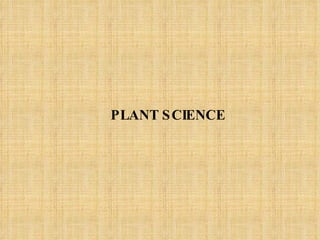
Plants PowerPoint
- 10. Male cone Immature female cone Mature female cone
- 15. Xerophyte adaptations (cont) 5. Stomata in pits and/or surrounded by hair -reduces air flow past pore -water that has diffused out will stay near -this reduces the concentration gradient and reduces the diffusion of water out of the plant
- 25. Xylem Phloem Pericycle Cortex of parenchyma cells Endodermis Epidermis Special layer with root Hairs (protoderm) Root hairs Root Anatomy (dicot)
- 30. High solute Low solute Root cell Soil H 2 O H 2 O Water Uptake by Roots **Water diffuses (osmosis) to an area of high solute concentration to reach equilibrium between the roots and the soil **Minerals are taken in via active transport because the roots have higher solute concentration than the soil
- 34. Cell membrane Cell wall Vacuole Casparian strip Cell membrane Cell wall Vacuole Water flow (cannot flow between cells when Casparian strips are present) Water flow Water flow without Casparian strips Water flow with Casparian strips
- 58. More on guard cells D. When the plant is at risk of drying out the guard cells lose turgor and sag together, closing the stomata E. This reduces water loss and photosynthesis F. Because photosynthesis is reduced guard cells only close the stomata when the plant is at risk G.Guard cells regulate transpiration by opening and closing the stomata. -A plant hormone called abscisic acid causes the stomata to close. (This is helpful during times of drought or stress.)
- 59. Anatomy of stomata and guard cells
- 60. Pea leaf stomata and guard cells
- 69. Path of pollen to fertilization Anatomy of a flower
- 70. Anatomy of a flower
- 72. Wind dispersal Exploding fruit This plant grows near water. The fruit bursts, the seeds fall in the water and the river carries them away. Pond Iris Impatiens capensis (orange spotted touch me not) Carduus nutans (nodding plumeless thistle)
- 77. A typical monocot seed
- 83. Phaseolus multiflorus seedling (after about two weeks)
- 86. The experiments indicated that flowering of each species was determined by a critical period of darkness (“critical night length”) for that species, not by a specific period of light. Therefore, “short-day” plants are more properly called “long-night” plants, and “long-day” plants are really “short-night” plants. (a) “Short-day” plants flowered only if a period of continuous darkness was longer than a critical dark period for that particular species (13 hours in this example). A period of darkness can be ended by a brief exposure to light. During the 1940s, researchers conducted experiments in which periods of darkness were interrupted with brief exposure to light to test how the light and dark portions of a photoperiod affected flowering in “short-day” and “long-day” plants. EXPERIMENT RESULTS CONCLUSION 24 hours Darkness Flash of light Critical dark period Light (b) “Long-day” plants flowered only if a period of continuous darkness was shorter than a critical dark period for that particular species (13 hours in this example).
- 89. Distinguishing between monocots and dicots Floral organs Tap roots w/ lateral branching Adventitious roots Root types Number of cotyledons Vascular tissue distribution Net-like Parallel Leaf venation Dicots Monocots